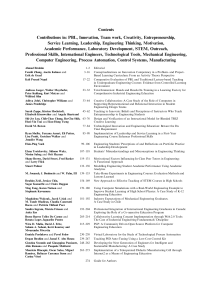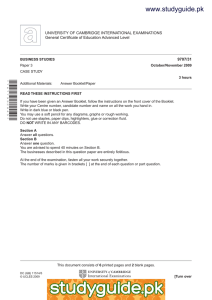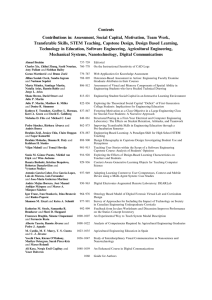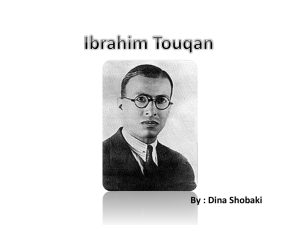www.XtremePapers.com UNIVERSITY OF CAMBRIDGE INTERNATIONAL EXAMINATIONS General Certificate of Education Advanced Level 9707/31
advertisement
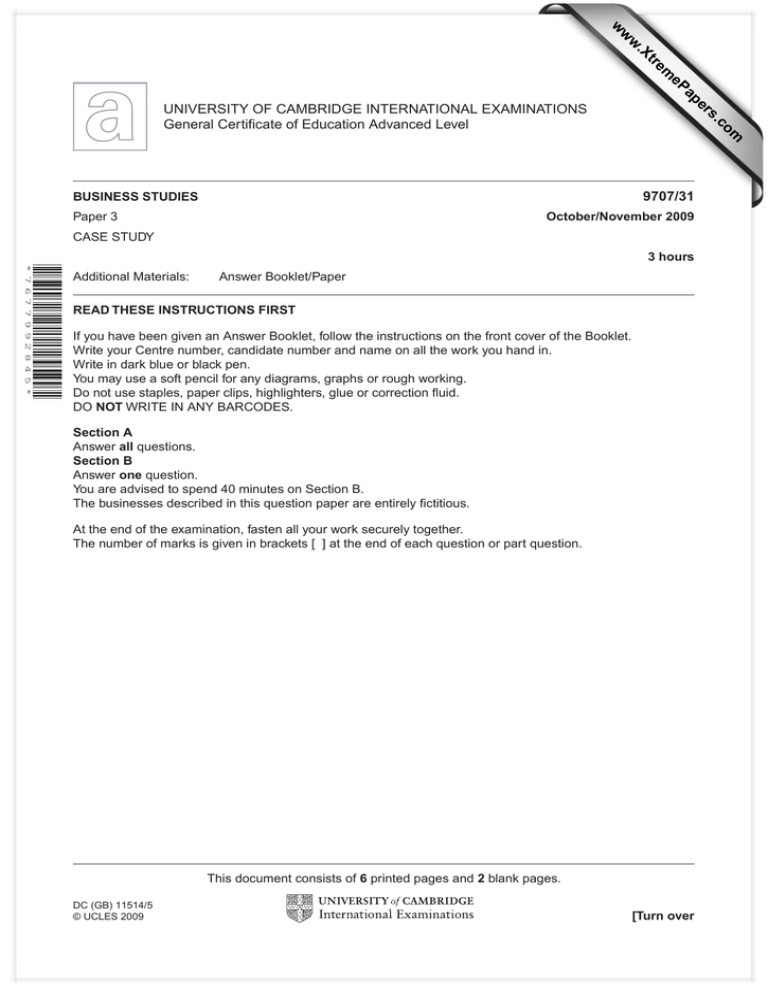
w w ap eP m e tr .X w om .c s er UNIVERSITY OF CAMBRIDGE INTERNATIONAL EXAMINATIONS General Certificate of Education Advanced Level 9707/31 BUSINESS STUDIES Paper 3 October/November 2009 CASE STUDY 3 hours *7677992845* Additional Materials: Answer Booklet/Paper READ THESE INSTRUCTIONS FIRST If you have been given an Answer Booklet, follow the instructions on the front cover of the Booklet. Write your Centre number, candidate number and name on all the work you hand in. Write in dark blue or black pen. You may use a soft pencil for any diagrams, graphs or rough working. Do not use staples, paper clips, highlighters, glue or correction fluid. DO NOT WRITE IN ANY BARCODES. Section A Answer all questions. Section B Answer one question. You are advised to spend 40 minutes on Section B. The businesses described in this question paper are entirely fictitious. At the end of the examination, fasten all your work securely together. The number of marks is given in brackets [ ] at the end of each question or part question. This document consists of 6 printed pages and 2 blank pages. DC (GB) 11514/5 © UCLES 2009 [Turn over 2 The Sauce Company Spicy sauce recipe serves up big profits It all started before Ibrahim was born. His grandmother had perfected a recipe for a spicy sauce to accompany many local foods. She served it with every meal! Made from fresh local fruits and spices it also contained a secret ingredient. One summer his grandmother made so many jars of sauce that Ibrahim, now 17, asked if he could try selling the surplus at a local market. Sales were slow at first but then he had the idea of offering free small portions of the sauce with bread. This promotion worked brilliantly. His market stall was soon surrounded by people eager to try – and then buy – this unique sauce. The surplus jars sold out quickly. This left Ibrahim with a problem. Should he ask his old grandmother to make another 100 jars of sauce – or should he ask for the recipe and try to make it himself? Ibrahim learns to cook The solution was to allow Ibrahim to mix and cook most of the recipe but for his grandmother to add the secret ingredient while he was out of the kitchen! They aimed to produce 150 jars a week in 3 batches of 50 jars. This proved not to be enough. The reputation of the sauce – which Ibrahim decided to call ‘Hi Spice’ – was spreading with free publicity from the local radio station and newspaper. Ibrahim had invited reporters to the market to come and see what all the fuss was about! Production expands When grandmother’s oven broke down due to the weight of the pans, Ibrahim had to take a big risk and buy a lease on a commercial kitchen. He formed a private limited company, called The Sauce Company, with his grandmother and several friends keen to invest in the business as shareholders. He had to move quickly to get production started again. He feared that not being able to supply customers could lead them to trying competitors’ products! It took him five weeks to find and equip suitable premises – longer than he had hoped. When production and sales restarted he was amazed to see all of his old customers back. He had put an advert in the newspaper to tell them about the delay in supply of ‘Hi Spice’ and this had been appreciated by his customers. 5 10 15 20 25 30 The new kitchen had a huge capacity and batches of 500 jars at a time could be made. Ibrahim had taken out a patent to protect the recipe. He agreed to pay fees to his grandmother for each jar sold – after she told him of the secret ingredient. The sauce was now being sold in several markets and staff had been employed to help with bottling, transport and serving on market stalls. 35 New flavours added and demand grows To widen the market appeal of the sauce, three new flavours were introduced – called Saucy Choices. This product differentiation allowed Ibrahim to charge much higher prices for these flavours. These three sauces were made by batch production, using huge stainless steel pans. These had to be cleaned after each batch. 40 © UCLES 2009 9707/31/O/N/09 3 The original Hi Spice sauce had been ordered in huge quantities by a well known supermarket chain. This company insisted on regular deliveries of 5000 jars a week. Ibrahim could now justify the use of flow production for Hi Spice. It would offer significant reductions in variable costs. An extension to the kitchen was built quickly despite the opposition of local residents. It was equipped with automated food processing, mixing, cooking and packing machines. Two additional specialist workers were employed and trained in the latest technology. Ibrahim wondered if the new machinery would be able to produce exactly the same ‘home made’ flavour of Hi Spice but he thought that customers would not notice anyway. Quality problems Once installed, the flow production of Hi Spice operated efficiently. However, the batch production of the three other flavours was contributing to quality problems. Customer complaints had started to be passed back to Ibrahim from the workers on the market stalls. Some jars of the Saucy Choices flavours, it was claimed, were underweight. Flavours seemed to be mixed up – perhaps the equipment was not being cleaned properly. Two customers even complained that their jars of sauce contained uncooked fruit and spices. Ibrahim, who had been spending most of his time managing the introduction of the automated equipment, decided to investigate. He discovered that the workers in the batch production section were poorly motivated. They were upset about the high pay offered to the flow production specialists. Ibrahim had not consulted them about the introduction of the new production method and he did not offer them jobs on the flow line. The batch production workers blamed each other for quality problems and they were in conflict with the quality control inspector. He had been rejecting many jars of sauces and workers’ pay had been reduced as a result. So the workers were trying to distract his attention when poorly prepared sauces were passing through quality control. Management vacancy Ibrahim’s response was to advertise for an Operations Manager. He clearly needed help to solve the quality problem. He wanted to appoint an Operations Manager who would be good at managing staff, meeting production targets and improving quality. He received thirty-five applications for the vacancy. He interviewed five people. He noted the following information on the two most promising candidates on his final shortlist. © UCLES 2009 9707/31/O/N/09 45 50 55 60 65 70 [Turn over 4 Candidate A Candidate B Current job Internal candidate: I am a flow production specialist for Hi Spice sauce. External candidate: I am deputy Operations Manager for a large food production company. Age 24 48 Current annual salary $6000 $12 000 Other work experience None Several different jobs with different production companies. Education University degree in Business and Operations Management. Cambridge A levels. Attended many off-the-job production training courses. Reasons for applying for this job ‘I know how the business operates. I am very ambitious. I can make a difference at The Sauce Company.’ ‘I am ready for more responsibility. I have experience at getting the best out of workers’. Table 1. Candidate data for the Operations Manager vacancy Future plans – the ‘Export Project’ Ibrahim had great plans for the business. He had paid for a market research report on food products. It stated that distinctive branded food products had great sales potential in many countries. It recommended further market research into each potential market, extensive advertising to inform consumers, careful choice of distribution channels and an appropriate pricing level. Ibrahim started making some revenue and profit forecasts based on one country in particular. His forecasts suggested that, compared to the 2008/2009 Profit and Loss Account shown in Appendix A, the following changes would occur: • • • • Sales revenue increase by 20% Cost of goods sold rise by 10% Promotion overheads up by 100% Increase in interest costs of 50%. Paying for this market development would not be easy. The market research suggested that an investment of $0.25m might be necessary. Ibrahim wondered if this huge sum could be raised internally or whether a large loan might be necessary. © UCLES 2009 9707/31/O/N/09 75 80 85 5 Appendix A: Profit and Loss Account, The Sauce Company for year ending 30th September 2009 $000 Sales Revenue 400 less Cost of Goods Sold 100 Gross profit 300 Overheads (including promotion expenses of 20) 140 Interest 10 Net profit 150 Tax @ 20% 30 Dividends 50 Retained profit 70 Appendix B: Extract from The Sauce Company Balance Sheet as at 30th September 2009 $000 © UCLES 2009 Fixed Assets 900 Current Assets 450 Stocks 250 Current Liabilities 500 Capital Employed 850 Long term Liabilities 450 9707/31/O/N/09 [Turn over 6 Section A Answer all questions in this section. 1 (a) Briefly explain two benefits to Ibrahim of the business being a limited company. [6] (b) Using Table 1 and other information in the case, recommend which candidate Ibrahim should appoint as Operations Manager. Justify your recommendation. [12] 2 Evaluate whether adopting Total Quality Management would be likely to solve the quality problems of Saucy Choices. [16] 3 (a) Draw up a revised Profit and Loss Account for The Sauce Company making the changes forecast by Ibrahim on lines 83–86. Assume no other changes. [6] (b) Evaluate the usefulness to Ibrahim of using break-even analysis to decide whether to go ahead with the ‘Export Project’. [8] 4 (a) Calculate the company’s gearing ratio and one liquidity ratio from the data in Appendix B. [6] (b) Using your results from (a) and other information, advise Ibrahim on the best way to raise the $0.25m required for the ‘Export Project’. [10] 5 Recommend an appropriate marketing strategy that Ibrahim might use to achieve a successful launch of Hi Spice sauce in your country. Justify your recommendation. [16] Section B Answer one question from this section. 6 Discuss the relative importance of the factors that you think were significant in making The Sauce Company a successful business. [20] 7 To what extent should Ibrahim consider the objectives of stakeholders other than shareholders? Justify your answer. [20] © UCLES 2009 9707/31/O/N/09 7 BLANK PAGE 9707/31/O/N/09 8 BLANK PAGE Permission to reproduce items where third-party owned material protected by copyright is included has been sought and cleared where possible. Every reasonable effort has been made by the publisher (UCLES) to trace copyright holders, but if any items requiring clearance have unwittingly been included, the publisher will be pleased to make amends at the earliest possible opportunity. University of Cambridge International Examinations is part of the Cambridge Assessment Group. Cambridge Assessment is the brand name of University of Cambridge Local Examinations Syndicate (UCLES), which is itself a department of the University of Cambridge. 9707/31/O/N/09
